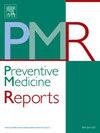Attendance patterns in well-child visits across diverse pediatric populations, Midwestern United States
IF 2.4
3区 医学
Q2 PUBLIC, ENVIRONMENTAL & OCCUPATIONAL HEALTH
引用次数: 0
Abstract
Objective
Routine well-child visits (WCVs) are essential for monitoring child health; however, substantial differences exist in attendance, particularly among non-Hispanic Black families. We quantified these disparities within a single healthcare system, comparing two distinct pediatric practice groups: one serving primarily non-Hispanic Black and one serving primarily non-Hispanic white children.
Method
This retrospective analysis included patients born in 2022 with at least one WCV in their first 15 months of life using electronic medical records from a healthcare system in the Chicago area. We assessed WCVs against American Academy of Pediatrics guidelines, using Pearson's chi-squared tests to compare attendance rates and logistic regression to calculate adjusted odds ratios (aOR) and 95 % confidence intervals (CI) for factors associated with attending 6 or more WCVs.
Results
Among 2567 eligible patients, 51.7 % were from Site 1 (predominantly non-Hispanic Black) and 48.3 % were from Site 2 (predominantly non-Hispanic white). Among Site 1 patients, 83.3 % attended six or more WCVs compared to 91.6 % from Site 2 (p < 0.001), with lower attendance at Site 1 observed starting at 2 months (aOR 0.55, 95 % CI 0.38, 0.80). Across all patients, patients with Medicaid insurance had 61 % lower odds of attending 6+ WCVs compared to commercially insured patients (aOR 0.39, 95 % CI 0.26, 0.58).
Conclusion
These findings highlight critical differences in WCV attendance among children within the same healthcare system. Lower at the site serving primarily non-Hispanic Black children may be attributable to barriers to healthcare access, including socioeconomic challenges and implicit bias in healthcare delivery.
美国中西部不同儿科人群中健康儿童访视的出勤模式
目的常规儿童健康检查(wcv)对监测儿童健康至关重要;然而,在出勤率上存在着巨大的差异,特别是在非西班牙裔黑人家庭中。我们在单一医疗保健系统中量化了这些差异,比较了两个不同的儿科实践组:一个主要服务于非西班牙裔黑人儿童,一个主要服务于非西班牙裔白人儿童。方法采用芝加哥地区医疗保健系统的电子病历,对2022年出生的15个月内至少有一种WCV的患者进行回顾性分析。我们根据美国儿科学会指南评估wcv,使用Pearson卡方检验来比较出勤率,并使用逻辑回归来计算参加6次或以上wcv相关因素的调整优势比(aOR)和95%置信区间(CI)。结果在2567例符合条件的患者中,51.7%来自1区(主要是非西班牙裔黑人),48.3%来自2区(主要是非西班牙裔白人)。在1区患者中,83.3%的患者参加了6次或更多wcv,而2区患者的这一比例为91.6% (p <;0.001),从2个月开始观察到Site 1的出勤率较低(aOR 0.55, 95% CI 0.38, 0.80)。在所有患者中,与商业保险患者相比,医疗补助保险患者参加6+ wcv的几率低61% (aOR 0.39, 95% CI 0.26, 0.58)。结论:这些发现突出了同一医疗保健系统中儿童WCV出勤的关键差异。在主要服务非西班牙裔黑人儿童的地点,较低的死亡率可能归因于获得医疗保健的障碍,包括社会经济挑战和医疗保健服务中的隐性偏见。
本文章由计算机程序翻译,如有差异,请以英文原文为准。
求助全文
约1分钟内获得全文
求助全文
来源期刊

Preventive Medicine Reports
Medicine-Public Health, Environmental and Occupational Health
CiteScore
3.90
自引率
0.00%
发文量
353
 求助内容:
求助内容: 应助结果提醒方式:
应助结果提醒方式:


